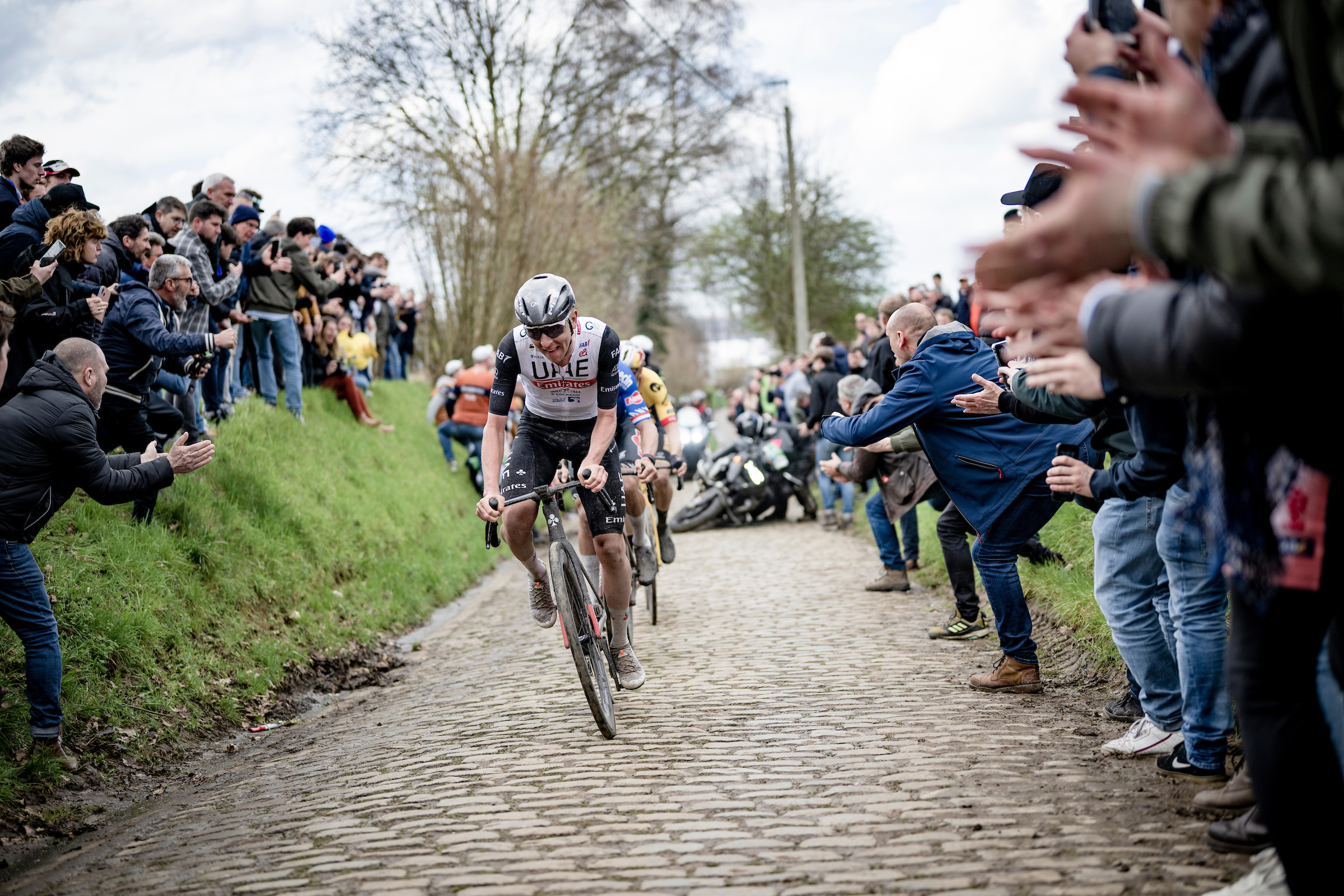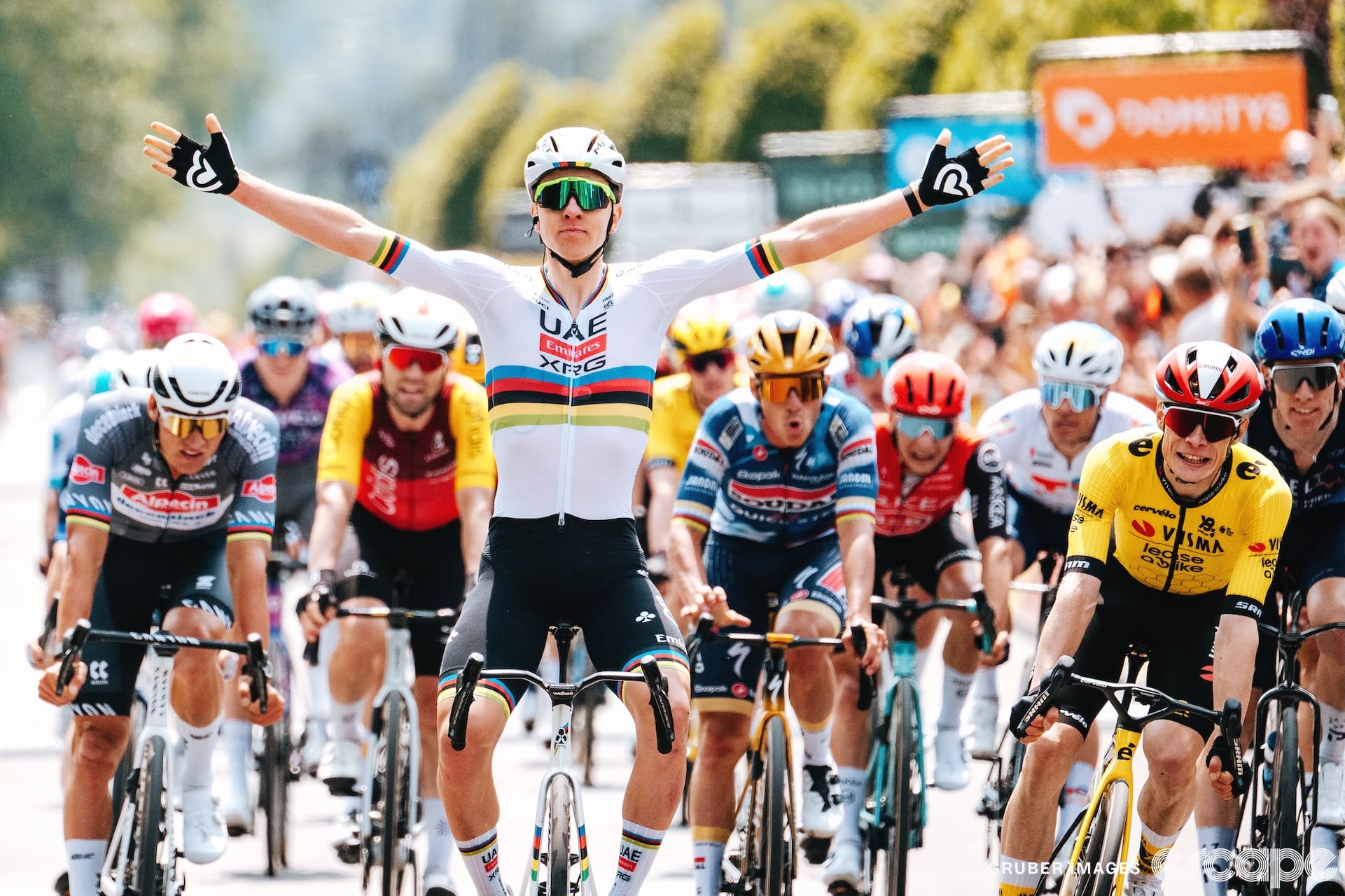Spring has sprung in Flanders and bike racing is in the air. The superstars of the Classics have put on some spectacular shows as they done battle over the past few weeks – and now it's time for Belgium's biggest bike race. The Tour of Flanders, De Ronde van Vlaanderen, is upon us.
To prepare you for the thrilling weekend ahead, we here at Escape Collective have compiled everything you need to know about the event. Abby Mickey has the preview of the women's race covered, and I've got everything you need to know about the men's race, as well as a few things that maybe you didn't know you need to know about historic Bruges and even Belgian beer.
What you need to know
Let's begin with what you really definitely absolutely need to know: When is the race and when should you tune in?
The 107th edition of the Tour of Flanders will roll out from Bruges on Sunday, April 2, at 10 am local time in Belgium (4 am EDT/10 am CET/8 pm AEST). The riders are expected to arrive at the finish in Oudenaarde at around 5 pm local time (11 am EDT/5 pm CET/1 am AEST). It's not a short race, but in our opinion, it really is worth trying to catch as much of the action as you possibly can. Moves made in the early goings often have a big impact on the race, and unlike in many other races, riders from the early break often contend in the finale even after they've been caught by a small group of favorites.
That said, if you absolutely must skip the first several hours, things should really start to heat up with around an hour and a half to go as the peloton arrives at the Oude Kwaremont for the second time. Even from that far out, big names may start to get feisty.
The route highlights
After making an Antwerp rollout the norm for the past several years, race organizers have shifted the men's start back to Bruges (aka Brugge in Dutch), the capital of the West Flanders region and a history lover's dream. The adjusted start means that roughly the first half of the event's 273.4 km will cover different roads from those traversed in last year's edition, but once the race rolls into East Flanders, things will start to look more like they have in recent years.
As usual, the race will ultimately roll into hillier territory as it approaches Oudenaarde, where the route begins to loop over itself to visit the cobbles and climbs we all know and love, sometimes more than once.

All told, there are 19 hellingen, or hills, and many of those are cobbled. According to the organizers, a further six sectors of road are deemed kasseien, or "cobbled," making for plenty of bumpy road between the start and the finish. As you probably know if you're reading a preview geared toward bike racing fans, the action really tends to heat up inside the last 60 km or so. That's when the peloton hits the Oude Kwaremont for the second time.
From there, it's onto the short but steep Paterberg and, after a brief respite, a rapid succession of cobbles, climbs, and cobbled climbs. The brutal Koppenberg is followed by the cobbled Mariaborrestraat sector, the Steenbeekdries climb, the Stationsberg cobbles, and then Taaienberg and Kruisberg climbs.
If recent races are any indication, the days of the big favorites waiting around until the finale may be behind us, but if they do, the race will likely be decided on the final Kwaremont/Paterberg pairing. After the descent off the Paterberg, it's only about 10 mostly flat kilometers to the finish in the town of Oudenaarde.
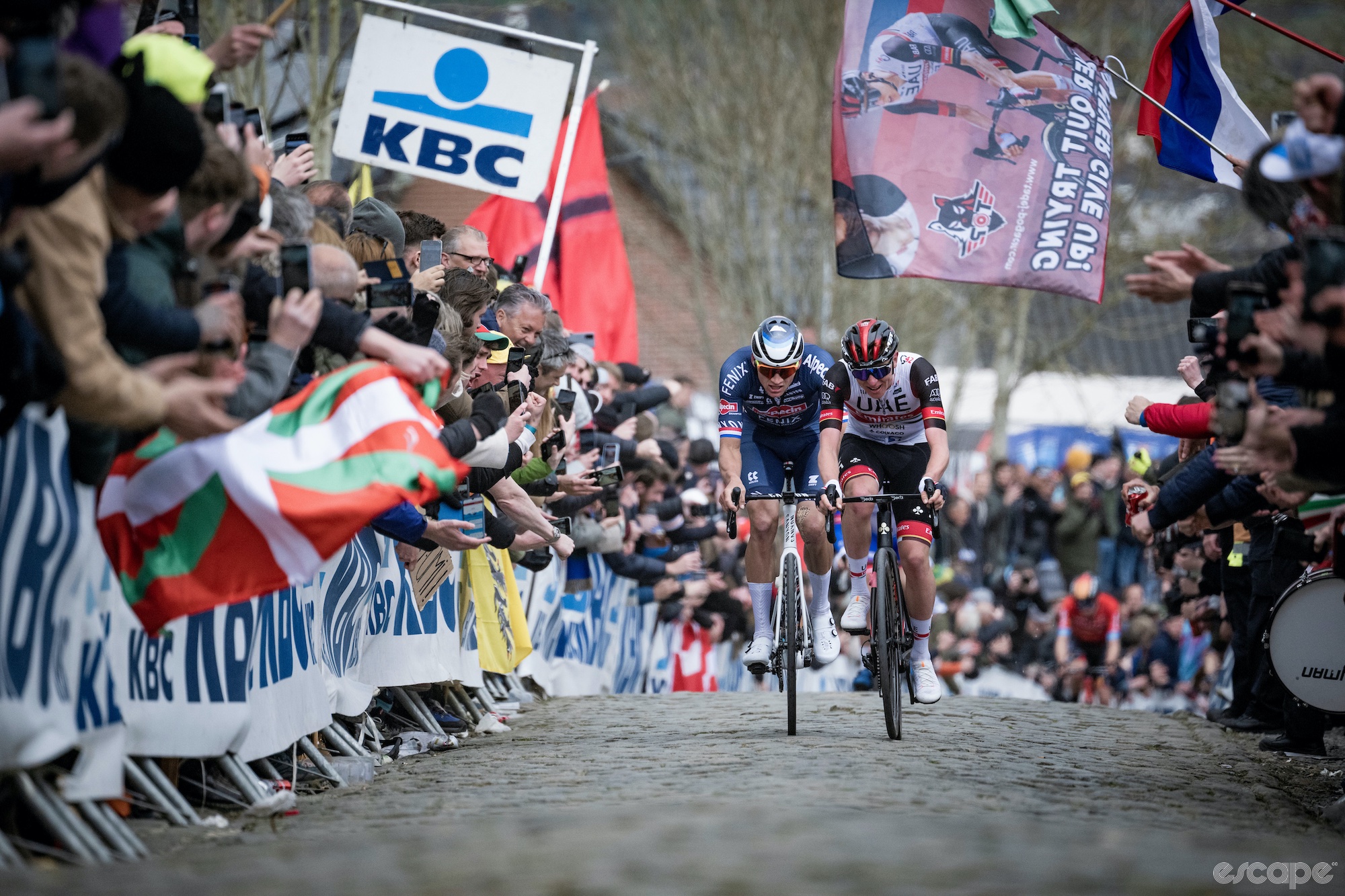
The various challenges on the route will likely be compounded by the weather. The forecast over the next several days is a rainy one. That could make the race harder to control, especially with the style of riding we've been seeing from the big names lately. Speaking of which …
The big three and their flying form
It's perhaps a bit unfair to the rest of the peloton to focus so squarely on Mathieu van der Poel (Alpecin-Fenix), Wout van Aert (Jumbo-Visma), and Tadej Pogačar (UAE Team Emirates), but there's no two ways about it: That's the trio everyone in the peloton will be watching on Sunday. Let's take a closer look at their bona fides.
Mathieu van der Poel is your bookies favorite headed into the weekend, which maybe isn't a surprise as he is the defending champion, the 2020 winner, and has never finished lower than fourth. His last few weeks of racing have looked pretty darn good too: He won Milan-San Remo and then was a close second behind Wout van Aert at the "mini-Flanders" that is the E3 Saxo Classic. That said …
Van Aert may have only finished third in San Remo, but he is fresh off that dominant victory at E3, where he showed that he can best Mathieu van der Poel in a sprint at the end of a hard day. What's more, at Gent-Wevelgem, his team strength was readily apparent, as he and Christophe Laporte blew away the field. Even with Dylan van Baarle absent from the roster, that's the area where Van Aert really has the advantage. With Gent/Dwars door Vlaanderen winner Laporte and Tiesj Benoot able to either chase down attacks or either make their own, Alpecin-Fenix and UAE Team Emirates will have their hands full.
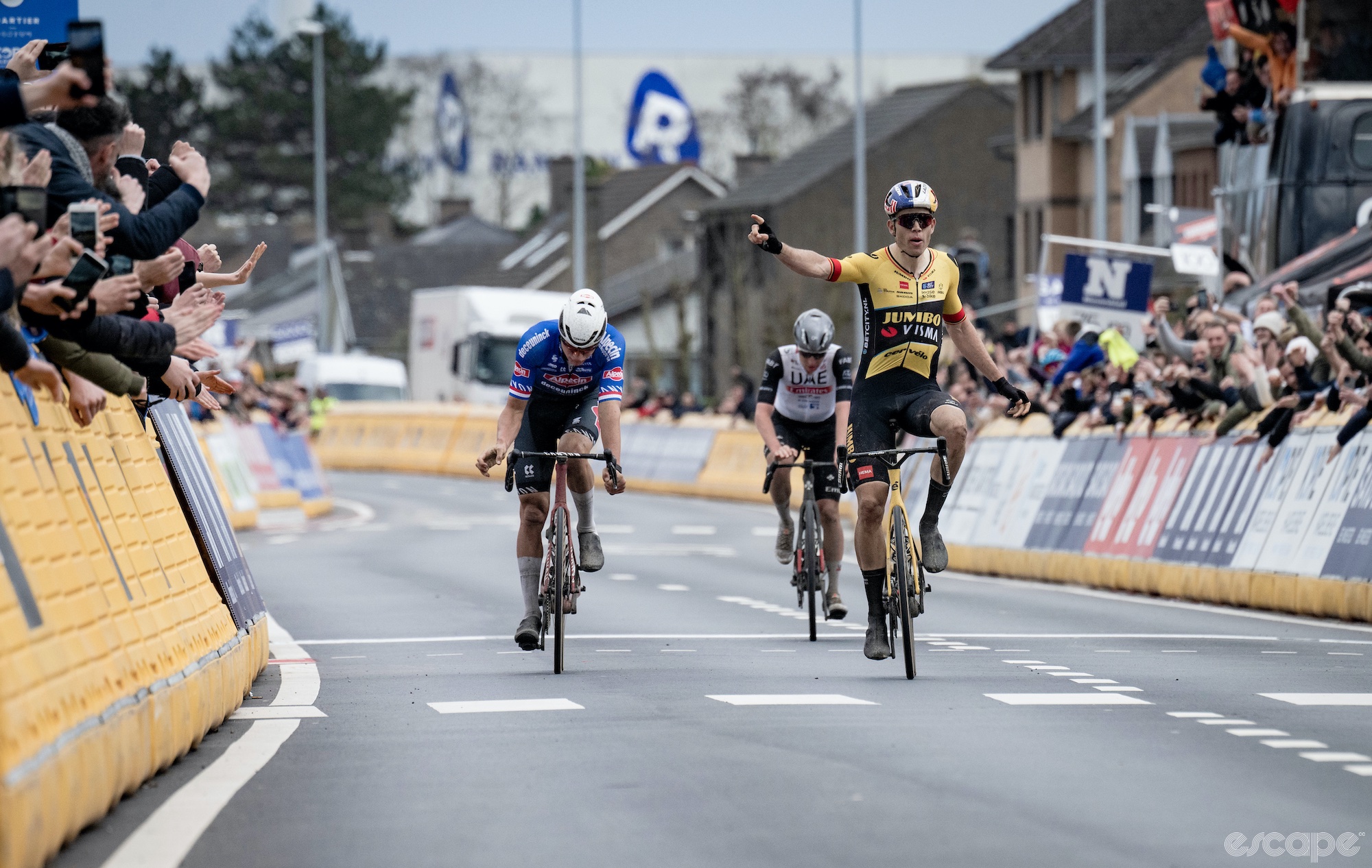
Pogačar is the real wild card, because he's more likely than his rivals to go on the attack, knowing he probably can't trust his sprint. The form is not a question mark. To recap, so far this year he has won the Clásica Jaén Paraíso Interior, three stages and the overall at the Vuelta a Andalucía, and three stages and the overall at Paris-Nice, as well as showing himself plenty strong in fourth at San-Remo and third at E3.
What Pogačar may need most of all is for Van Aert and Van der Poel to be too busy watching each other. He may find common cause with someone from Soudal-QuickStep (Julian Alaphilippe or Kasper Asgreen), Trek-Segafredo (Jasper Stuyven or Mads Pedersen), or the Ineos Grenadiers (Tom Pidcock).
The Escape Collective star ratings
⭐⭐⭐⭐⭐: Mathieu van der Poel, Wout van Aert
⭐⭐⭐⭐: Tadej Pogačar
⭐⭐⭐: Christophe Laporte, Tom Pidcock
⭐⭐: Kasper Asgreen, Julian Alaphilippe, Jasper Stuyven, Mads Pedersen, Tiesj Benoot
⭐: Stefan Küng, Neilson Powless, Michael Matthews, Biniam Girmay, Valentin Madouas, Matej Mohorič
The Conversation
As usual, we always like to get additional takes from our fine collection of star cycling analysts, especially when we have a difference of opinion on something. As the Tour of Flanders looms, I caught up with Abby Mickey to talk about the whole big three thing. Here's how our conversation played out:
Dane Cash: OK, Abby, I just wrote a preview section about the big three for this race but personally, I actually kind of think it's more like a big two. I'm not as high on Pogačar's chances as everybody else is – but he is your pick to win. Help me understand why I'm wrong.
Abby Mickey: I think that he has the ability to attack on that final string of climbs and solo his way to the win. If he comes to the line with the other two that you are talking about, then I think his chances are lower, but I think he can get away from them.
DC: Do you think that because he's that much stronger than them? That he can attack on the Kwaremont or the Paterberg and actually leave them in the dust? I just don't know if he's strong enough. I don't know if the climbs are big enough or long enough.
AM: Yeah, but he's exceptional. I think that because of who he is, if it was any other rider who had won the Tour de France, then you'd never be talking about him in the first place. But the fact that he's even in the big three, as you call it, I think that, in and of itself, puts him in a good position to win. And for me, looking at how he's been riding already, he's made some mistakes and I think he will learn from those mistakes and that will favor him to win on Sunday.
DC: That's a really good point. The ceiling, then, is even higher maybe, because we've seen him not be perfect so far. So, if he rides a perfect race maybe it works out. I think the other thing that's in his favor is if maybe Van Aert and Van der Poel are too busy watching each other and then neither one chases when Pogačar attacks.
AM: Yeah, that could absolutely happen. They are the two favorites of every single one of these races for a reason and I think that the way that they both have been racing recently and how they've come up against each other recently is only going to be to advantage because they're so focused on each other. I think the bigger problem for Pogo to win is going to be the team that Van Aert has behind him. I feel like Van der Poel is like this loose cannon when you look at how the race could unfold. But Van Aert, he's this exceptional rider who also has this ridiculous team behind him.
DC: Yes, even with Dylan van Baarle a late scratch, Jumbo still has so much firepower.
AM: Whoever else wants to win will have to play off of them.
DC: Which seems like a tall order.
Our picks
Dane Cash: Wout van Aert
Abby Mickey: Tadej Pogačar
Caley Fretz: Tom Pidcock
Jonny Long: Mathieu van der Poel
Ronan Mc Laughlin: Tadej Pogačar
Kit Nicholson: Valentin Madouas
Matt de Neef: Wout van Aert
What you didn't know you need to know
To really immerse you into this most holy day in this most cycling-crazed of places, let's dive into the history of the famously historic start town and then dish out a bit of knowledge that will help you keep your thirst quenched as the races unfolds.
Bruges is a glittering reminder of this area's medieval past. The County of Flanders, ostensibly within the French feudal orbit, enjoyed a great deal of independence in the Middle Ages – and started to make a great deal of money as a center of commerce. Bruges and nearby Ghent and Ieper were among the wealthiest cities in Europe in the period. If you walk through Bruges today, the canals will transport you back in time to the city's bustling mercantile past, as will the medieval architecture. The city center is a particular highlight with its iconic 83-meter tall belfry, various parts of which date to the 13th, 14th, and 15th centuries. The eye-catching Bruges City Hall, built over 600 years ago, is another must-see, as is the Basilica of the Holy Blood.
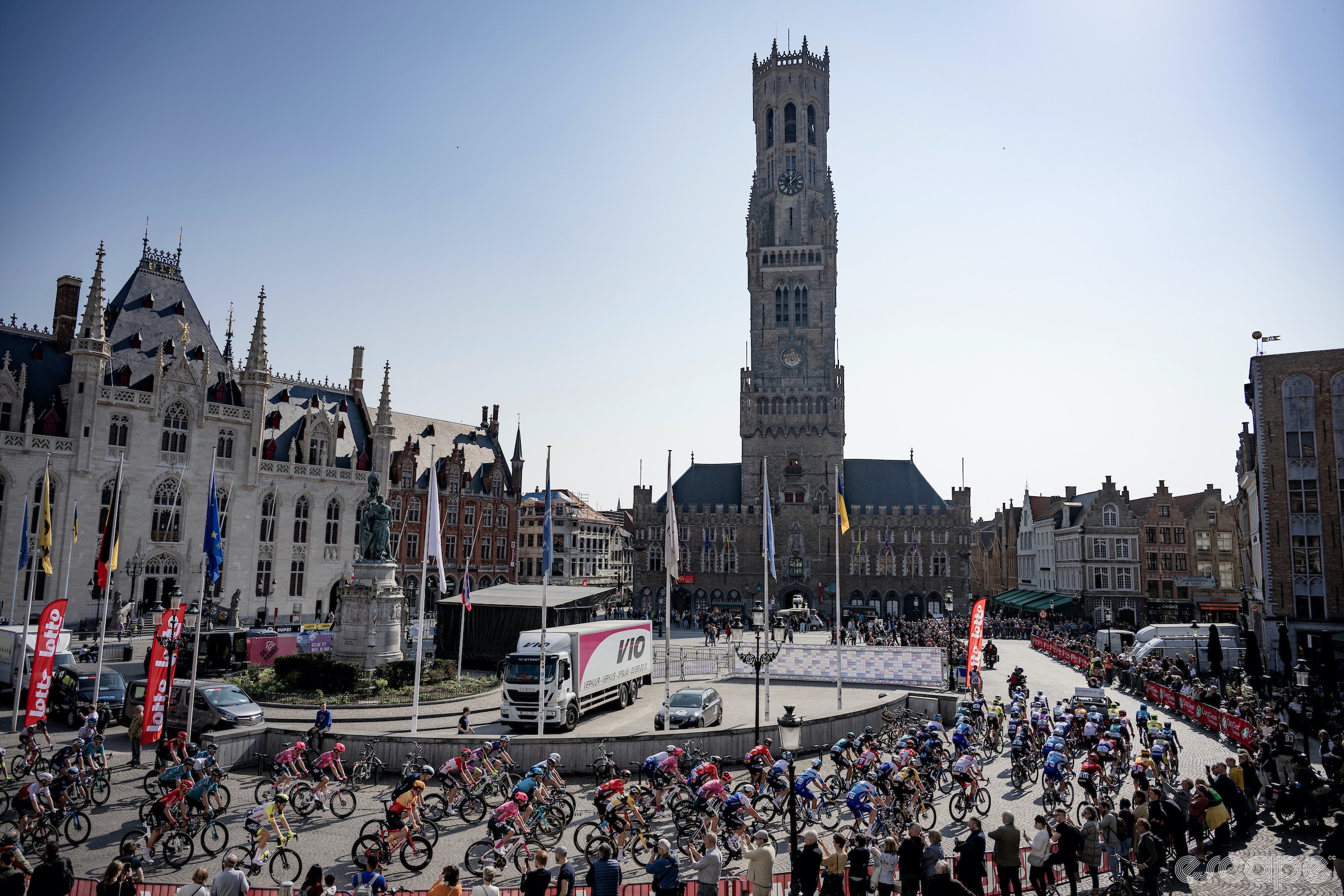
Right then. You've probably worked up a thirst reading all of that history stuff, so let's talk beer, because this is Flanders after all. I'm a big wine guy but a bit of a beer novice, so I figured I would direct my efforts to those readers who are also relatively uninitiated in beer, and I've whipped up an explainer on a topic that always mystified me. Specifically: What's the difference between a Duvel and a dubbel? And what's the difference between a dubbel, a tripel, and a quadrupel?
Hang around beer nerds long enough and you'll hear all of these terms, so let's dive in, starting with Duvel, the beer brand that is immensely popular in Belgium. The name comes from the word for "devil" in certain dialects of Flemish. According to the brewery that makes it, the beer got its modern name about a hundred years ago when someone described it as "a real devil." It's a flavorful pale ale and it packs some punch at 8.5% ABV.
So that's the Duvel brand, but what about all those beers that say "dubbel" on the label? Despite the superficial similarity of those words, they refer to entirely different things. "Dubbel" and its cousins "tripel" and "quadrupel" are Dutch for exactly what you think they mean, and they are essentially marketing terms to describe different styles of beer. The origins of the terms are debatable and their specific meanings are vague, but things seem to have started, at least for Dubbels, at the Westmalle Brewery near Antwerp. The Trappist monks there decided to try to make something newer and stronger than their standard offering. They called it the "Dubbel" and the name stuck. Eventually, when someone decided to put another brand new spin on the monastery beer, they upped the ante on the name and called it the Tripel. Later, an innovating brewer elsewhere came up with a new product and decided it just had to be called a Quadrupel.
Nowadays, various breweries use those names to refer to beers they sell. A dubbel tends to be on the darker side as beers go, robust in both taste and alcohol content. For research, I tried the classic Westmalle Dubbel and quite liked its notes of caramel and malt, and its lack of hoppiness.
It would seem reasonable to assume that a tripel would be even darker, but that assumption would be wrong. Really, there's not much rhyme or reason to this. Most tripels are quite pale. They are indeed high in alcohol, but instead of having those traditional dark beer notes, they tend to be hoppy and fruity. If you're into that, the Tripel Karmeliet from Bosteels Brewery – which is a little over an hour from the Oudenaarde finish line in East Flanders – is absolutely exploding with flavor, slightly acidic, and maybe even a bit spicy.
As for Quadrupels, only a handful of breweries have beers marketed under that name, but those that do so generally make a very strong medium-dark ale that manages packs both malty and fruity flavors into the package. St. Bernardus Brewery, based in Watou a little more than an hour from Bruges in West Flanders, makes the Abt 12, which has about 10% ABV and is beloved by beer nerds the world over.
That's probably a lot of information to take in, but truth be told, watching 273.4 km of bike racing should give you plenty of time to try out a Duvel, a dubbel, a tripel, and a quadrupel if you're up for it. You might even squeeze in a Flanders red like the Rodenbach I'm currently drinking (again, for research purposes only) for something totally different. Just remember to pace yourself. This is De Ronde, after all. You'll want to be fresh for the finale.
Did we do a good job with this story?

